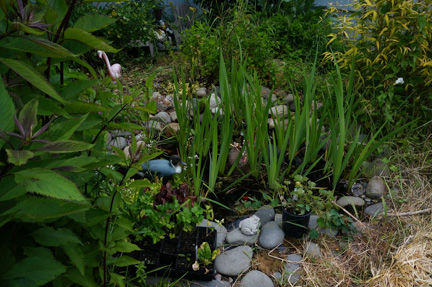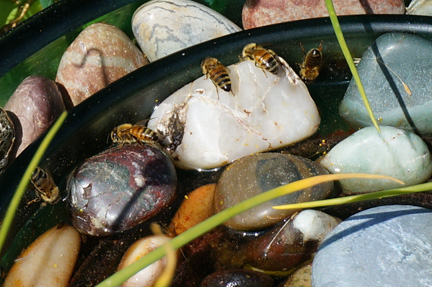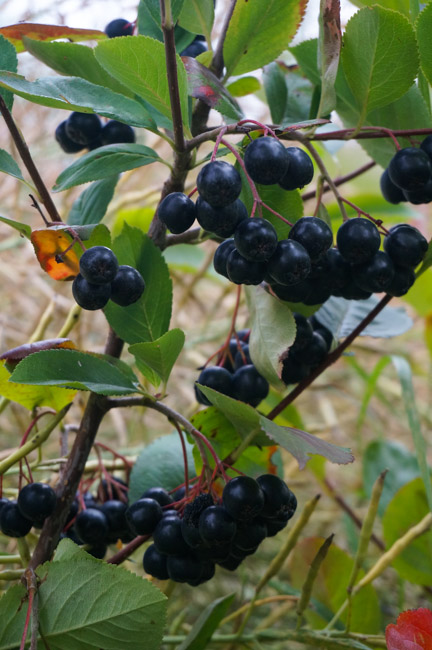As it turns out, they often go together.
We purchased this property in 1995, so I thought I knew the property fairly well. However, in re-examining it in the light of permaculture ideas, in doing some research, and also through my own observations, I did, indeed, encounter quite a few challenges, and in the process of resolving them, some revelations, and hey – hopefully I learned something, too! Quite often, it’s all a matter of turning a problem into a solution…
Sun
Challenges: How to best take advantage of the sun in a cool temperate climate, particularly when trees on the south side shade the house, which is not oriented or in a place to take advantage of solar energy.
Surprises, Lessons, Solutions:
Summer Sun: Deciduous trees to the south create much more summer shade than realized. Plus, at some times of the year, those shadows tend to be very long – as well as long-lasting!
With our house facing west, we always felt the heat of the afternoon summer sun, so I thought it would be the perfect place to plant tomatoes, which could take advantage of that thermal reflection. Not so! By the time the sun moves around to directly west, it is late afternoon – perfect for afternoon barbecues, but the tomatoes did better elsewhere in the garden.
Winter Sun: I had planted a nice little garden on the east side of the house for plants that would appreciate protection from the west winds and the warmth of the morning sun in winter (most notably, an interesting blue bean tree). However, the sun in winter stays so low in the sky, by the time it gets above the tall firs on the neighbor’s property across the road, it is almost noon – and by that time, it is on the other side of the house, heading for an early sunset behind the mountains (as if our winter days aren’t short enough!). Some areas on the east side of the house never do get out of the shadows in winter, and with that early twilight, it’s no wonder I need more Vitamin D!
Solar Energy: We enjoy some of the lowest electrical rates in the country, but still, it would give us great pleasure to get a check FROM the PUD – or at least reduce our dependence on this utility. Unfortunately, our house, built around 1905, was not constructed with the idea of taking advantage of solar energy, and trees on the south side shade it most of the year. It appears, however, that the barn roof is in an open enough area and oriented the right direction to capture some of that sunlight so celebrated in the land of the “Blue Hole.” Unfortunately, the barn is located quite a distance from the house. We are still learning about how to make this work. Other ideas are to add two solar rooms, on the east and west sides of the house, to capture some heat, add a little ambiance, and infiltrate much needed light into an otherwise relatively dark house.
Earth
Challenges:
- Our land is flat! (except for the two sides where it descends steeply through blackberry brambles to roadways). Is that a good thing or a bad thing?
- We get hammered with rain during the few months that it falls, and it just soaks straight down into the ground. It is hard to see where a swale or pit would make any difference.
- The soil is diverse! Decent loam in some places with streaks of pure hard clay; other areas are like an old gravel river bed – all rock.
- Buying mulch gets expensive! Increasing soil health without a convenient source of animal manure is a challenge.

Surprises, Lessons, Solutions:
Ok. So our land is NOT exactly flat. In fact, it’s rather lumpy (mostly from mole activity). There is a slight slope before the land drops off into a tangle of blackberries. There is also a mound that overlooks the neighboring farmland on the west edge (it might have been a dumpsite for earlier residents; we find old car parts out there). There are also a few areas of slight depression that might make good starting points for pond construction or rain gardens.
Raised beds can go both ways: where there’s a raised bed, there is also a pit. It doesn’t have to be a path around the bed – it can also be a growing area – one in which the water sinks. The lessons have been in understanding different pit and berm configurations, where to place them, for what types of plantings they might be appropriate, and how that might change throughout the growing season.
Raised beds don’t have to be rectangles. Something circular, a spiral, a U form, or something that follows paths can provide more edge, are a better heat sink, and create more diversity in microclimates.
Building the soil is a life-long process that is never done! It is interesting to note that the county soil profile was actually pretty accurate. Many of the weedy species – mugwort, wormwood, thistles, grasses – and also many of the wildflower plants – poppies, lupine, bachelor buttons – do well in gravelly soils. They also provide quite a bit of mulch if we are careful to cut them down before they go to seed. We are gradually building soil through planting preferred plants such as clovers, vetch, rye, and field peas, and and mulching as much as possible. The judicious planting of green manure crops and sometimes clearing a patch of weeds to put in something that will contribute more nutrients to the soil is important. Plant selection is also key. Many of the Mediterranean herbs do well in dry, rocky, exposed areas. Some of the native plants do fine in areas where there is a lot of clay or acid soil. In some cases, clay can be dug up and used for cob construction projects.
Although buying a truckload of woodchips is expensive (no freebies available!), the garden has responded favorably, especially in the orchard, which produces good flushes of mushrooms in the spring and fall.
Water

Challenges:
- When it rains, it rains. When it doesn’t, it doesn’t for a long time. Rain catchment barrels quickly fill up during the rainy season, but they are not enough to water the garden during dry spells.
- The irrigation ditch alongside the property is a real advantage; but it is a disadvantage of being too dependent on it. The ditch is usually turned off in mid-September (this year is an exception), which is often the driest time of year and when plants feel the full drought accumulated from previous months the most. Local regulations prohibit the routing of the ditch water into ponds. Efficient watering systems and systems that do not rely on supplemental ditch water are imperative.
- Need a more efficient way of watering; standing out there with a hose takes way too much time!
- We would like to re-use our greywater, but where could we route it? And would there be a way around local regulations?
- I would like to create a small duck pond – but where?
Surprises, Lessons, Solutions:
There are a lot of different ways to capture rainwater or use water more effectively. Drip irrigation systems in the past have not been successful because of too much debris and algae in the irrigation ditch, the source of the water. Better filtration systems would be required. Also different means of routing hoses, now that the garden areas are much more complex – but anything that reduces time spent holding a hose would be good!
Other means of focusing water to needed areas or of reducing water requirements can be surprisingly effective:
A small trench (or channel) down the center of a bed can give a place for the water to run and soak in and make the water last longer.
Sunken sources of water and nutrients with plants in a circle in a bed around it, e.g., a watering container (maybe with compost tea), a compost pile, worm “bins” (5-gallon buckets sunk into the ground that allows the leachate to soak to nearby plants) all work really well.
Lots of mulch reduces evaporation and acts as a sponge.
Trees create microclimates: in plots where there are a circle of trees, the inner areas stay remarkably cooler and hang on to the morning dew much longer.

Rain gardens and small ponds are the ultimate answer to using leftover rainwater! Small & slow solutions! I dug a small pond to catch the overflow from one of the rainwater tanks, and in it my grandson and I ceremoniously released a few 10-cent goldfish. After 4 years, they are still alive! No supplemental feeding required. The overflow from the pond went into a slight dip where I planted a few water-loving plants. It is surprising that it has worked so well and how well the plants have thrived.
Based on that success, I dug another pond to catch the overflow from the second tank in amongst the basketry willows. I put a simple kiddy pool in the hole (not a lot of creative edge there – but it was a beginner’s experiment). I tossed a little duckweed in it, which quickly took over. The bees loved it! They could stand on the duckweed and drink without falling in! Overflow was piped to another pit, which was left empty (no pool). It doesn’t appear to be doing much – in fact, it’s more of a hazard because someone might not see it beneath all the overbrush and fall in. Hmmm. Based on the overgrowth, I guess it must be working after all! I would like to provide some kind of cistern or catchment basin for every roof runoff area that directs overflow into raingardens.
My original idea was to route the greywater along the south side, a shaded area with a mix of water-loving plants and some hardy natives. However, I was advised “at your peril!” The ground there has a lot of clay and could be quite unstable. Would the added water deepen the roots of trees? Or make them more likely to topple over? A slight depression in the ground more to the west might be a better location. It is located away from the drainfield and far enough that routed water could filter through plants before reaching a destination area that could be dug out further, with the earth used to create berms/beds and an area for ducks.
Plants & Animals
Challenges:
- A lot of plants should do well here in a mild Zone 8, but do not. Mortality is high with new plants because of wind and weather patterns. Other plants – mostly weeds – redefine tenacious, and easily choke them out if not protected.
- Finding time to complete all the tasks required in taking care of orchards, shrubs, berries, etc. Everything is ready to harvest at once!
- Ensuring that there is something blooming for the bees at all times of the year — and knowing whether it is enough – can be a real challenge.
- There has been a bit of a learning curve when it comes to the bees. We lost three hives this summer – and determining exactly why is also a challenge.
- “Wild” animals can be a real problem: deer, moles, voles, and an invasion of tent caterpillars and bald-faced hornets have been challenging!
Surprises, Lessons, Solutions:

“Permaculture” plants that are supposed to live in zone 8 do not necessarily do well here because we don’t get enough heat units. Plants can also put on a lot of new growth in the warm temperatures of early spring and then be very susceptible to late frosts and other weather fluctuations. Windbreaks, creation of microclimates, and due diligence the first year on weeding can help their chances. Other somewhat uncommon plants, however, have done very well. People are always amazed at the diversity of things they haven’t heard of: the Medlar tree, aronia berries, Autumn olive, seaberries, beach plums, goumi berries, strawberry trees, Cornelian cherries, wolfberries, cardoon, mashua root, oca root, and scorzonera to name a few.
Too much of a good thing? Thank you, Bees! Berry crops are prolific; thinning apples is a necessity; judicious pruning can make a huge difference. The lesson here has been to start small and build slowly – which we did not do! The other lesson is to Share the Surplus, which sometimes means wildlife or turning back into the soil.
Weeds are more tenacious than I realized. Layers of cardboard covered with several inches of wood chips did not deter quackgrass or bindweed. Black plastic covering the grass in the orchard for an entire year did not kill them. Piles of mulch did not kill off thistles. Bindweed can grow beneath lumber and carpet and even cement. It can be overwhelming. Another lesson in starting small and building on successes.
The willows have outgrown expectations. In fact, from the office window, they are taller than the mountains! And this is a problem. The lesson is to be careful where you plant willows! When the catalog says they grow 10-feet tall, that means in a season if you cut them down. If you let them grow, they turn into trees! And if I coppice them, they will just grow back again. So much so, in fact, that I am finding all kinds of uses for willows I might not have tried before: trellises, plant cages, compost containers, racks, weavings, spheres, sculptures, root-starting hormone… I am thinking of using them to build a zig-zag fence as a windbreak across the property.
A grassy field can be a good thing! The amount of mulch that can be grown and harvested with a scythe on a relatively small plot of ground is nothing short of amazing. It keeps you in shape, it reduces stress, it gives you a sense of accomplishment. I love scything!
 Providing housing for the bees has been a huge learning experience and has increased our awareness of other pollinators, whether insect, bird, or mammal, tremendously. Most interesting has been a greater appreciation of the complexity of ecosystems and how nature and pollinators work together to ensure survivability of both. However, taking on the role of “Bee Guardian” carries a certain responsibility, and when a beehive fails, it is truly a tragedy. We have taken the opportunity to try to figure out the causes, learn more about the different factors that affect their survivability, and provide a haven for them as best we can.
Providing housing for the bees has been a huge learning experience and has increased our awareness of other pollinators, whether insect, bird, or mammal, tremendously. Most interesting has been a greater appreciation of the complexity of ecosystems and how nature and pollinators work together to ensure survivability of both. However, taking on the role of “Bee Guardian” carries a certain responsibility, and when a beehive fails, it is truly a tragedy. We have taken the opportunity to try to figure out the causes, learn more about the different factors that affect their survivability, and provide a haven for them as best we can.
We have yet to harvest any honey, because we have not felt it appropriate to take away what they have worked so hard to produce to make it through the winter. However, in the spring, we have had multiple swarms, possibly from an overabundant food supply and other factors. Learning about the behavior of bees has been both a challenge and a discovery. Watching a swarm of bees gather in the air and land on a nearby tree or shrub is nothing short of breathtaking! Learning about bees has been a great way to conquer fear.
The harvest of fruit, berries, and seeds of all kinds has been incredible! Thank you, bees! We may not get honey, but the fruit has been bountiful and the seeds are of very high quality.
I have an increased appreciation for insects, in particular, and animals that I used to think of as pests: spiders and wasps, for example, are important. I left a paper wasp nest that is built right by the door inside the mini-greenhouse. The wasps are right by my head every time I walk in there, and because it is such tight quarters, I almost hit them when I turn around. I leave them be and never once have they tried to attack me. One day, I watched them carrying a baby slug up the walls to their nest. They had the determination of an ant as they climbed and fell and climbed again. Clearly, they are my friends. Bald-faced hornets – by the thousands – in the willow room? To my amazement, they, too, never attacked me, although I was up quite close to them. I even provided them water. We had an unusually large aphid population on the willow trunks, and they were clearly much more interested in the aphid honeydew. I hung a willow ball in the center of the dome, and it could possibly be they thought it was another’s nest. Hornets are quite territorial and won’t build a nest if another is already there. I never found their nest, which is usually a football-sized paper mache hanging from a roof or tree.
I also had a change in attitude about other critters: Snails in the greenhouse – friend or foe? They are keeping the walls clean. Is there a potential for raising escargot? The French have been doing it for years. How about crickets? The moles and voles do a lot of damage to young trees, leaving their roots bare and dry or sometimes eating a whole row of carrots – but perhaps they aerate and fertilize the soil and eat a lot of bugs, too. I am not as quick to set traps; however, I might build a few owl houses (and bat houses, too!)
Birds! Maybe it’s not practical to have chickens right now, but the increase in bird populations since we started growing so many more plants – and a diversity of plants – has been remarkable. We have found that they really appreciate poles (perches) stuck in the ground throughout the garden. We place them where we would like them to deposit a few extra nutrients for us. It is not a good idea to plant a pole right next to a preferred food source, however – such as goji berries.
The incredible diversity possible in a backyard garden – the multiple benefits to humans and other creatures – the sheer beauty of how everything is coming together as plants grow over the season and over years – and all the birds and insects and other animals they attract – has been one of the greatest pleasures in this endeavor.
Additional Challenges:

Summer winds blow hard nearly every afternoon. Storms whip through here in the fall and winter with a ferocity that forces all small birds to hunker down in a safe place; however, wind energy is not, at the moment, a viable option. It is too variable. There are too many times of complete calm. It is also expensive. As technologies come more within reach, we will revisit this option, but for now, I am considering a small side-business making kites and windsocks!
Retrofitting our house: Built in 1905, it needs a lot of work! Increasing efficiencies, re-doing the plumbing to use greywater, building a cob stove, adding solar rooms and solar hot water, and figuring out whatever ways we can to make the house more efficient and reduce our footprint are all high on our priority list.
A big challenge and a lesson has been that I started too large, too quickly, and have been too spread out. Sometimes the project has been a bit overwhelming. Small and slow solutions is good advice.
The project itself was a challenge, in particular:
- Figuring out how to convert a traditional orchard to a food forest,
- Deterining whether different approaches to gardening would mean I would have to give up my garlic business, which is something I have worked very hard to establish, and where could I rotate what was essentially a monocrop when I was filling up all the space with perennials?
- Trying to figure out our zones, when at times they didn’t seem to make any sense, and not having clearly defined zones from the beginning – but then looking for relationships between areas, tasks, paths, plants, and seeing more clearly how it fit – or could fit with a few modifications
- Looking for patterns, when I had planted overstory plants according to spacing, but without trying to create anything aesthetic, like a mandala – but gradually recognizing patterns in the landscape and across time and space that I could emulate
- Figuring out how to map the project. Agggh! Such a learning curve in figuring out the best way to draw maps, sectors, zones, garden areas, etc. and upload it to a website! Much easier with paper and colored pencils!
- Figuring out new opportunities for creating fun and relaxing places to “be” in what is becoming a small jungle of biodiversity situated between small traditional farms and urban “planned-development” sprawl.
- Figuring out where to take this next. How can I share this with others?










